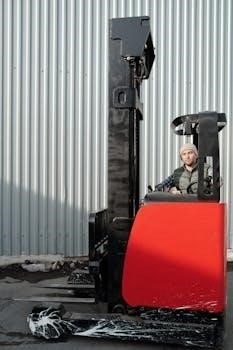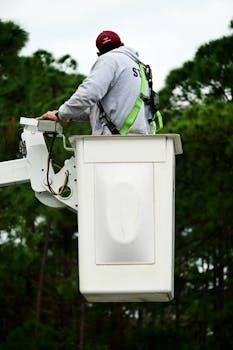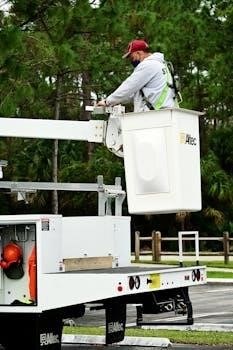Eaz Lift ReCurve R3 Manual⁚ A Comprehensive Guide
Welcome to your comprehensive guide to the Eaz-Lift ReCurve R3 weight distribution hitch! This manual will provide information, installation instructions, and maintenance tips for optimal performance. Understanding the manual ensures safe and effective operation.
The Eaz-Lift ReCurve R3 is a weight distribution hitch designed to enhance towing safety and stability. It features adjustable sway control, allowing you to customize the level of sway resistance based on your towing conditions. This hitch is engineered to distribute weight evenly across your tow vehicle and trailer, improving handling and reducing stress on your vehicle’s suspension.
The ReCurve R3 boasts a 1200 lb. maximum tongue weight rating, making it suitable for a wide range of trailers. By understanding the ReCurve R3’s design and function, you can maximize its benefits and ensure a smoother, safer towing experience.
This guide will walk you through the key features of the ReCurve R3, provide step-by-step installation instructions, and offer troubleshooting tips for common issues. Whether you’re a seasoned tower or new to the world of RVing, this comprehensive manual will equip you with the knowledge to confidently operate and maintain your Eaz-Lift ReCurve R3.
Effectively dampening trailer sway and improving overall control, the ReCurve R3 offers a significant upgrade in towing performance.

Key Features of the ReCurve R3
The Eaz-Lift ReCurve R3 boasts several key features designed to improve your towing experience. Its adjustable sway control is paramount, allowing you to fine-tune the level of sway resistance to match varying road conditions and trailer loads. By simply adjusting the clamp, you can decide how much sway control is needed.
Another notable feature is its weight distribution capability. The ReCurve R3 effectively transfers weight from the rear of the tow vehicle to the front axle, resulting in more stable handling and reduced vehicle sag. This leads to improved steering and braking performance, especially during emergency maneuvers.
The hitch’s robust construction ensures durability and long-lasting performance. The lift handle assists in raising the lift bracket, making setup easier. Its compatibility with a wide range of trailers, thanks to its 1200 lb. maximum tongue weight rating, adds to its versatility. The ReCurve R3 also allows for the sway control to be turned completely off when needed in dangerous road conditions.
These combined features make the Eaz-Lift ReCurve R3 a reliable and effective weight distribution and sway control solution.
Understanding Weight Distribution
Weight distribution is a critical concept in towing, directly impacting the safety and stability of your vehicle and trailer. When a trailer is hitched to a vehicle without a weight distribution system, the tongue weight exerts excessive downward force on the rear axle. This can cause the rear of the tow vehicle to sag, lifting weight off the front tires and compromising steering and braking.
A weight distribution hitch, like the Eaz-Lift ReCurve R3, addresses this issue by redistributing the tongue weight more evenly across all axles of the tow vehicle and the trailer. This is achieved through the use of spring bars that apply leverage, transferring weight forward to the front axle. The result is a leveler ride height, improved handling, and enhanced braking performance.
Proper weight distribution ensures that all tires maintain optimal contact with the road, maximizing traction and control. It also reduces stress on the vehicle’s suspension and frame, extending its lifespan. Understanding and implementing weight distribution is essential for a safer and more comfortable towing experience.
Sway Control Functionality
Sway control is a vital aspect of safe towing, especially when dealing with larger trailers or encountering challenging road conditions. Trailer sway, the side-to-side movement of the trailer, can be induced by various factors, including wind gusts, uneven road surfaces, and sudden maneuvers. Without effective sway control, this movement can become amplified, leading to a loss of control and potentially dangerous situations.
The Eaz-Lift ReCurve R3 incorporates adjustable sway control functionality to mitigate these risks. The system works by creating resistance to rotational movement between the trailer and the tow vehicle. This resistance dampens the effects of external forces, preventing sway from developing or escalating.

The adjustability of the sway control allows you to fine-tune the level of resistance based on the specific characteristics of your trailer and towing conditions; By increasing the resistance, you can enhance stability and reduce sway, particularly in adverse weather or on winding roads; Conversely, you can decrease the resistance for smoother turning and maneuvering in less demanding situations. Understanding how to properly adjust the sway control is crucial for maximizing its effectiveness and ensuring a safer towing experience.
Installation Guide⁚ Step-by-Step Instructions
The correct installation of your Eaz-Lift ReCurve R3 is paramount for ensuring optimal performance and safety. Before commencing, carefully inventory all components to ensure nothing is missing. Refer to the parts list in your manual. You’ll typically need wrenches, sockets, and possibly a torque wrench for proper tightening.
Begin by attaching the hitch head to the tow vehicle’s receiver, securing it with the provided pin and clip. Next, mount the support brackets onto the trailer’s A-frame, ensuring they are positioned according to the measurements specified in the manual. These brackets will provide the attachment points for the spring bars.
With the brackets in place, insert the spring bars into the hitch head and connect them to the support brackets using the lift chains. Use the provided lift handle to raise the spring bars into the locked position. Ensure the chains are properly tensioned to distribute weight effectively. Finally, double-check all connections and tighten all bolts to the specified torque. A thorough inspection is crucial before towing.
Safety Precautions During Installation
Prioritizing safety during the installation of your Eaz-Lift ReCurve R3 is crucial to prevent injuries and ensure the proper functioning of the hitch system. Always wear appropriate personal protective equipment (PPE), including safety glasses and work gloves, to shield yourself from potential hazards. Work in a well-lit and ventilated area to maintain clear visibility and avoid inhaling fumes.
Before starting the installation, ensure the tow vehicle and trailer are parked on a level surface and properly secured with wheel chocks to prevent any unexpected movement. Disconnect the trailer’s electrical and braking systems to eliminate the risk of electrical shock or accidental brake activation.
When handling heavy components, use proper lifting techniques or seek assistance to avoid strain or injury. Be mindful of pinch points and sharp edges on the hitch components. Never exceed the specified torque limits when tightening bolts, as over-tightening can damage the hardware and compromise the hitch’s integrity. Regularly inspect all connections and components for any signs of wear or damage, and replace them immediately if necessary.

Adjusting the Sway Control
Fine-tuning the sway control on your Eaz-Lift ReCurve R3 is essential for optimizing towing stability and handling. The ReCurve R3 features adjustable sway control, allowing you to customize the resistance based on your towing conditions and preferences. Begin by ensuring your weight distribution is properly set, as this forms the foundation for effective sway control.
To adjust the sway control, locate the adjustment mechanism on the hitch head. This typically involves tightening or loosening a clamp or adjusting the tension on the sway control arms. Consult your R3 manual for specific instructions and diagrams related to your model. Make small, incremental adjustments, testing the performance after each change.
Consider factors like trailer weight, road conditions, and wind speed when setting your sway control. Higher resistance is generally preferred for heavier trailers or windy conditions. Conversely, lower resistance might be suitable for lighter trailers or calm weather. Remember, the goal is to minimize trailer sway without compromising maneuverability or creating excessive stiffness. It is possible to turn off the sway control in icy conditions.
Proper Hitch Maintenance
Maintaining your Eaz-Lift ReCurve R3 hitch is crucial for ensuring its longevity, safety, and optimal performance. Regular inspection and lubrication are key components of a good maintenance routine. Before each use, visually inspect all hitch components, including the hitch head, spring bars, chains, and brackets, for any signs of wear, damage, or corrosion. Pay close attention to welds, bolts, and fasteners, ensuring they are secure and in good condition.
Lubrication is essential for smooth operation and preventing premature wear. Apply grease to all moving parts, such as the ball mount, spring bar sockets, and sway control components. Use a high-quality grease specifically designed for trailer hitches. Regularly clean the hitch to remove dirt, debris, and road salt, which can accelerate corrosion. After cleaning, re-lubricate all moving parts.
When storing your hitch, protect it from the elements by keeping it in a dry, covered location. Consider using a hitch cover to shield it from rain, snow, and sun exposure. Periodically check the torque on all bolts and fasteners, tightening them as needed to maintain proper tension. Following these maintenance practices will help extend the life of your Eaz-Lift ReCurve R3 hitch and ensure safe towing for years to come.
Troubleshooting Common Issues

Even with proper installation and maintenance, you might encounter issues with your Eaz-Lift ReCurve R3 hitch. Here are some common problems and their potential solutions. Excessive trailer sway can often be attributed to improper weight distribution. Ensure that the trailer is loaded correctly, with approximately 10-15% of the trailer weight on the tongue. Adjust the spring bar tension to fine-tune the sway control. If the hitch is noisy, creaking or groaning during turns, lubrication is likely the solution. Apply grease to all friction points, including the ball mount, spring bar sockets, and sway control components.
Difficulty attaching or detaching the spring bars can be caused by excessive tension. Use the lift handle to relieve tension before attempting to connect or disconnect the bars. Ensure that the lift brackets are properly adjusted and aligned. If you experience binding or resistance when adjusting the sway control, inspect the clamp and adjustment mechanism for damage or debris. Clean and lubricate the components as needed.
Inspect the hitch head and shank for cracks or deformation. Replace any damaged components immediately. By addressing these common issues promptly, you can maintain the safe and effective operation of your Eaz-Lift ReCurve R3 hitch.
Using the Lift Handle
The lift handle is a crucial component for operating the Eaz-Lift ReCurve R3, facilitating the engagement and disengagement of the spring bars. Correct usage of the lift handle ensures safety and ease of use. To begin, insert the lift handle onto the lift bracket rod, positioning it above the lift chain hook. This leverage point is designed for optimal lifting force. With the handle securely in place, begin to raise the lift bracket. It’s important to lift “up and over” the center point.
This action increases tension on the spring bars, effectively distributing weight and engaging the sway control. When attaching the spring bars, raise the lift bracket high enough to easily slide the spring bar into its designated socket. Avoid forcing the spring bar, as this could damage the components or create a safety hazard. When detaching, use the lift handle to raise the bracket again, relieving tension on the spring bar before removing it.
Always ensure a firm grip on the lift handle and maintain a stable stance during operation. Never attempt to use the hitch without the lift handle. Store the lift handle in a safe and accessible location when not in use. Regular inspection of the lift handle for bends or damage is recommended.
Maximum Tongue Weight Rating
Understanding the maximum tongue weight rating of your Eaz-Lift ReCurve R3 is paramount for safe towing; The ReCurve R3 boasts a 1200 lb maximum tongue weight rating, offering robust support for a variety of trailer setups. Exceeding this rating can lead to compromised handling, increased sway, and potential damage to your vehicle and trailer. Always consult your vehicle’s owner’s manual and the trailer’s specifications to determine the appropriate tongue weight for your specific setup.
Tongue weight refers to the amount of weight the trailer exerts on the hitch ball. It’s crucial to accurately measure your trailer’s tongue weight. You can use a tongue weight scale for the most precise measurement. Distribute the load within your trailer to achieve the ideal tongue weight. Aim for approximately 10-15% of the total trailer weight to be on the tongue. Shifting heavier items forward increases tongue weight, while moving them rearward decreases it.
Regularly check your tongue weight, especially after loading or unloading cargo. Maintaining the correct tongue weight within the ReCurve R3’s limits ensures stable towing, prevents excessive strain on the hitch, and contributes to overall safety on the road.
Turning Sway Control On/Off
The Eaz-Lift ReCurve R3 offers the flexibility to engage or disengage the sway control feature as needed. Understanding when and how to turn the sway control on or off is essential for adapting to different driving conditions.
To adjust sway control, locate the clamp. By adjusting the clamp, you can decide how much sway control is active. The ReCurve R3’s design allows for easy adjustments, enabling you to customize the level of sway control to match your preference and the driving environment.
In normal towing conditions, with dry roads and moderate winds, activating the sway control is recommended. This helps to minimize trailer sway, promoting a smoother and safer towing experience. However, in certain situations, such as driving on icy or slippery roads, it may be beneficial to temporarily turn off the sway control. Disengaging sway control in these conditions can allow for more natural handling and prevent potential overcorrection.
Always exercise caution and reduce your speed when towing on slippery surfaces. Familiarize yourself with the ReCurve R3’s sway control mechanism and practice adjusting it before embarking on a trip. Regularly inspect the sway control components for wear or damage. Proper adjustment and maintenance ensure reliable performance and enhance towing safety.
Where to Find the R3 Manual
Accessing the Eaz-Lift ReCurve R3 manual is crucial for understanding its operation, installation, maintenance, and troubleshooting. Fortunately, the manual is readily available through several convenient channels. One of the easiest ways to obtain the manual is online.
Many retailers and RV parts suppliers that sell the ReCurve R3 provide a digital copy of the manual on their websites. Look for a “Downloads” or “Support” section on the product page. The manufacturer, Eaz-Lift, may also host the manual on their official website. Searching for “Eaz-Lift ReCurve R3 manual” on a search engine will often lead you directly to a downloadable PDF version.
Another option is to check online RV forums and communities. Often, users will share links to the manual or offer to email a copy. Be cautious when downloading files from unofficial sources, and ensure your device has appropriate security software installed.
If you purchased the ReCurve R3 new, a printed copy of the manual should have been included in the packaging. Check the box carefully before discarding it. If you are unable to find a physical or digital copy, contact Eaz-Lift directly. Their customer service department can assist you in obtaining the manual you need.

